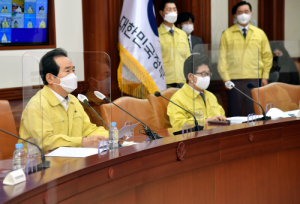As of midnight on Tuesday, November 17, the Korea Disease Control and Prevention Agency (KDCA) reported 230 confirmed cases of COVID-19, raising fears that the country is facing another outbreak of the pandemic. South Korea has now recorded confirmed cases in the triple digits for nine days in a row. Its the highest number of confirmed cases in South Korea since it successfully controlled an outbreak linked to churches in August.
Prime Minister Chung Sye-kyun said in a meeting on Tuesday that “the country faces a crisis of disinfection,” adding that the situation in the greater Seoul area, where more than half of the total population is concentrated “is particularly very serious.”
Chung also acknowledged how hard strengthening social distancing would be for people and small business owners, but explained it was a necessary decision as the country has already experienced several outbreaks in this year.
Health experts have demanded that the government raise its social distancing level from 1 to 1.5 or 2 as the number of cases has been steadily rising. In November, South Korea introduced a 5-tier social distancing system to help manage government responses based on current pandemic conditions in the country.
To respond to the high daily count of confirmed cases, fueled by consistent group outbreaks, the government announced on Tuesday that it will tighten precautionary measures. It raised the level of social distancing from 1 to 1.5 in the greater Seoul area, where the bulk of new cases are being reported.
Under the new level, no more than 100 people can gather for events such as rallies and concerts. Attendees at sporting events will be limited to 30 percent of each stadium’s capacity. Likewise, religious facilities will have to cap gatherings at 30 percent of capacity.
People must sit at least one seat apart from each other in indoor facilities such as theaters and concerts. Crowd numbers will be limited in indoor gathering spots like clubs, karaoke and indoor sports facilities.
The new rules are scheduled to take effect Thursday.
Amid the new wave of COVID-19, KDCA Commissioner Jeong Eun-kyeong warned on Monday that the number of daily confirmed cases may be double from the current count of about 200. Already, South Korea has reported more than 200 confirmed cases three days in a row.
“Researchers who make predictions based on modeling expect nearly 300 to 400 [daily] confirmed cases in two to four weeks,” Jeong said.
Roh Kyoung-ho, a professor of laboratory medicine at the National Health Insurance Service Ilsan Hospital, told The Diplomat on Tuesday that it was necessary for authorities to raise the level of social distancing, even though it could affect the economy.
“When people do not follow social distancing guidelines while they hesitate to open the door each day to waft fresh air inside from November to February, the number of daily confirmed cases can reach to 400,” Roh said.
Medical experts have said that this winter will be the most difficult time for the country in the battle with COVID-19. It is a time when respiratory infections are usually rife and the virus itself can survive well in cold temperatures.
“I think the only way to avoid doubling the number of daily confirmed cases in the future is to continue to run 5 to 8 million tests a day using our current virus scanning capabilities,” Roh said.
He added, “I believe that now is the last crisis in quarantine before the commercialization of vaccines.”
The government knows how aggressive social distancing guidelines affect people’s lives, and seemed reluctant to take action. It was criticized by the public for resisting new guidelines over the weekend. However, the government decided to pull the lever on Tuesday to prevent a possible skyrocketing number of confirmed cases. South Korea has already experienced two waves of COVID-19, largely caused by group infections of church-goers in February and August.
Amid the new restrictions, self-employed people and small business owners are expected to face financial difficulties once again.
South Korea, which has about five confirmed cases per million people, is doing better with the pandemic than the United States, which has about 150 confirmed cases per million, and many European countries, according to data from the Johns Hopkins COVID-19 database. However, the government has not relaxed its vigilance due to the fact that more than half of the population lives in the greater Seoul area and there is high population density.
As of Tuesday midnight, South Korea’s total caseload has climbed to 28,998, with 494 deaths. Of the 230 cases reported that day, 202 cases were local transmission and 28 were imported. About 68 percent of the local cases were caused in the greater Seoul area, according to KDCA data.

































